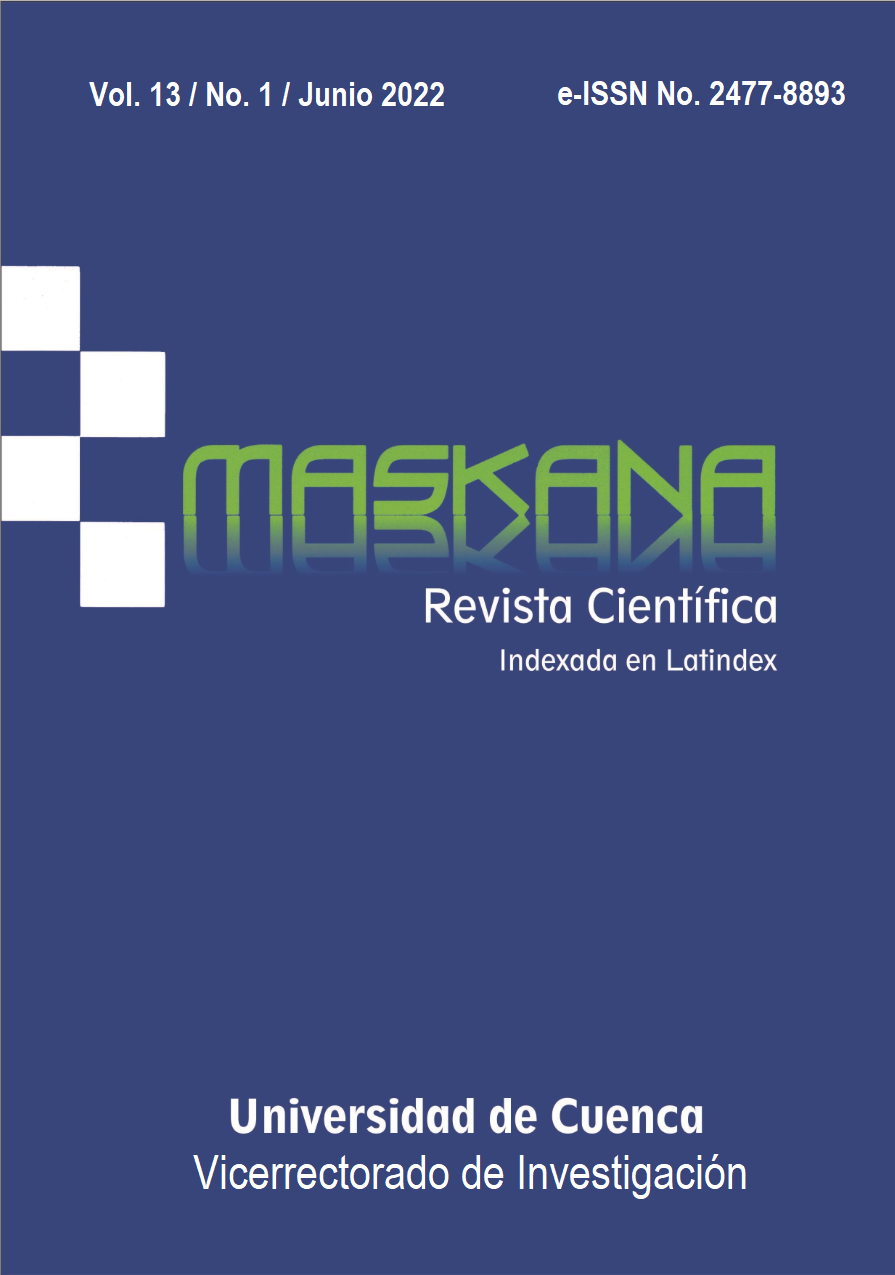Analysis and optimization of corrugated carbon/epoxy sandwich panels under compression
DOI:
https://doi.org/10.18537/mskn.13.01.08Abstract
This research was carried out with the purpose of analyzing and optimizing a corrugated carbon/epoxy sandwich panel subjected to compressive loads, since traditional optimization techniques for composite structures are not applicable or are very limited. A practical and simple calculation methodology was used to determine the optimum behavior and configuration of the panel by means of an analytical optimization model. The results were then validated through a finite element model (FEM), where differences of 4% were found between the two models with symmetrical laminates and 25% with asymmetrical laminates, so that the methodology developed is only useful for designs with symmetrical laminates, which suggests that a theory that allows considering the asymmetry of the laminates should be included. The methodology used could serve as a basis for the collection of new results and possible comparisons.
Downloads
Metrics
References
Albazzan, M. A., Harik, R., Tatting, B. F., & Gürdal, Z. (2019). Efficient design optimization of nonconventional laminated composites using lamination parameters: A state of the art. Composite Structures, 209, 362-374. https://doi.org/10.1016/j.compstruct.2018.10.095
Awad, Z. K., Aravinthan, T., Zhuge, Y., & Gonzalez, F. (2012). A review of optimization techniques used in the design of fibre composite structures for civil engineering applications. Materials & Design, 33,
-544. https://doi.org/10.1016/j.matdes.2011.04.061
Balasubramanian, M. (2014). Composite materials and processing. (1a ed.). Boca Raton, Taylor & Francis Group, 167-265 pp.
Barbero, E. J. (1999). Introduction to composite materials design. (1a ed.). New York, Taylor & Francis Group, 183-216 pp.
Barbero, E. J. (2013). Finite element analysis of composite materials using abaqus. (1a ed.). New York, Taylor & Francis Group, 35-187 pp.
Campbell, F. C. (2004). Manufacturing process for advanced composites. (1a ed.). New York, Elsevier Ltd., 132-163 pp.
Chantieva, M. E., Dzhabrailov, K. A., Iluhin, A. V., & Gematudinov, R. A. (2019, March). Software optimization methods for composite materials. In: 2019 Systems of signals generating and processing in the field of on board communications (pp. 1-4). IEEE. https://doi.org/10.1109/SOSG.2019.8706771
Catapano, A., & Montemurro, M. (2014). A multi-scale approach for the optimum design of sandwich plates with honeycomb core. Part II: the optimisation strategy. Composite structures, 118, 677-690. https://doi.org/10.1016/j.compstruct.2014.07.058
Gholami, M., Alashti, R. A., & Fathi, A. (2016). Optimal design of a honeycomb core composite sandwich panel using evolutionary optimization algorithms. Composite Structures, 139, 254-262. https://doi.org/10.1016/j.compstruct.2015.12.019
Jácome-Guevara, F. A., Coello-Tapia, L. A., & Zurita-Caisaguano, J. R. (2022). Fabricación de los Fan Blades de materiales compuestos de un motor Turbofan de uso Aeronáutico. Dominio de las Ciencias, 8(2), 1134-1151. https://dx.doi.org/10.23857/dc.v8i2.2696
Jones, R. M. (1999). Mechanics of composite materials. (2a ed.). Virginia, Taylor & Francis Group, 1999, 2-362 pp.
Kassapoglou, C. (2010). Design and analysis of composite structures: With applications to aerospace. (1a ed.). United Kingdom, John Wiley & Sons, 33-138 pp.
Kollar, L. P. (2003). Mechanics of composite structures. (1a ed.). New York, Cambridge University Press, 63-166 pp.
Lu, T., Liu, T., & Deng, Z. (2008). Thermoelastic properties of sandwich materials with pin-reinforced foam cores. Science in China Series E: Technological Sciences, 51(12), 2059-2074. https://doi.org/10.1007/s11431-008-0226-2
Matthews, F. L. (2000). Finite element modelling of composite materials and structures. (1a ed.). North America, Woodhead Publishing Limited, 3-30 pp.
Montemurro, M., Pagani, A., Fiordilino, G. A., Pailhès, J., & Carrera, E. (2018). A general multi-scale two-level optimisation strategy for designing composite stiffened panels. Composite Structures, 201, 968-979. https://doi.org/10.1016/j.compstruct.2018.06.119
Nikbakt, S., Kamarian, S., & Shakeri, M. (2018). A review on optimization of composite structures Part I: Laminated composites. Composite Structures, 195, 158-185. https://doi.org/10.1016/j.compstruct. 2018.03.063
Nielsen, L. F. (2005). Composite materials properties as influenced by phase geometry. (1a ed.). New York, Springer, 65-151 pp.
Rao, S. S. (2009). Engineering optimization theory and practice. (4a ed.). New York, John Wiley & Sons, 63-235 pp.
Reddy, J. N. (2004). Mechanics of laminated composite plates and shells theory and analysis. (2a ed.). Florida, CRC Press LLC, 109-156 pp.
Voyiadjis, G. Z. (2005). Mechanics of composite materials with MATLAB. (1a ed.). Heidelberg, Springer, 47-189 pp.
Wang, Z., & Sobey, A. (2020). A comparative review between Genetic Algorithm use in composite optimisation and the state-of-the-art in evolutionary computation. Composite Structures, 233, 111739. https://doi.org/10.1016/j.compstruct.2019.111739
Wadley, H. (2003). Fabrication and structural performance of periodic cellular metal sandwich structures. Composites Science and Technology, 63(16), 2331-2343. https://doi.org/10.1016/S0266-3538(03)00266-5
Wolf, K. (2001, April). Optimization of composite sandwich panels using evolutionary computation methods. In 19th AIAA Applied Aerodynamics Conference (p. 1277). https://doi.org/10.2514/6.2001-1277
Zhang, J., Supernak, P., Mueller-Alander, S., Wang, C. H. (2013). Improving the bending strength and energy absorption of corrugated sandwich composite structure. Materials and Design, 52, 767-773. https://10.1016/j.matdes.2013.05.018
Zurita-Caisaguano, J. R., Coello-Tapia, L. A., & Jácome-Guevara, F. A. (2022). Análisis sistemático de estructuras de materiales compuestos (carbono-epoxi) tipo sándwich, utilizadas en aplicaciones aeronáuticas. Dominio de las Ciencias, 8(2). https://dx.doi.org/10.23857/dc.v8i2.2682
Published
How to Cite
Issue
Section
License
Copyright (c) 2022 Luis Coello-Tapia, Fausto Jácome, Jonathan Zurita, Diego Bustillos

This work is licensed under a Creative Commons Attribution 4.0 International License.
Copyright © Autors. Creative Commons Attribution 4.0 License. for any article submitted from 6 June 2017 onwards. For manuscripts submitted before, the CC BY 3.0 License was used.
![]()
You are free to:
 |
Share — copy and redistribute the material in any medium or format |
 |
Adapt — remix, transform, and build upon the material for any purpose, even commercially. |
Under the following conditions:
 |
Attribution — You must give appropriate credit, provide a link to the licence, and indicate if changes were made. You may do so in any reasonable manner, but not in any way that suggests the licenser endorses you or your use. |
| No additional restrictions — You may not apply legal terms or technological measures that legally restrict others from doing anything the licence permits. |








